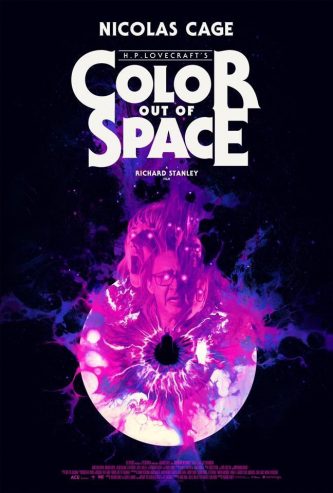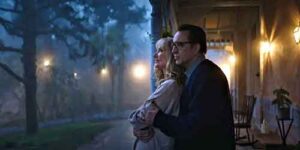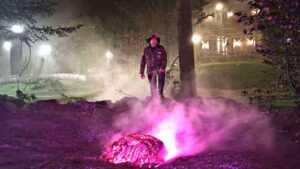The January, 2020 release of THE COLOR OUT OF SPACE was something of an event for horror fans. Why? Because it’s the first feature in over 25 years to be directed by Richard Stanley. Previous Stanley films include HARDWARE (1990) and DUST DEVIL (1992), the former of which marked one of the most promising debuts of the nineties and the latter the fulfillment of that promise.
COLOR OUT OF SPACE, adapted from H.P. Lovecraft’s immortal 1927 tale “The Colour out of Space” by Stanley and frequent writing partner Scarlett Amaris, doesn’t approach the brilliance of DUST DEVIL, nor the transcendent eeriness of Lovecraft’s story (which was previously adapted in DIE, MONSTER, DIE! and DIE FARBE). It’s worthwhile nonetheless, being quite evidently the work of a talented filmmaker who we’re lucky to have back in our midst.
In H.P. Lovecraft’s fictional town Arkham the alpaca enthusiast Nathan Gardner (Nicolas Cage) lives in a forest mansion with his wife Theresa (Joely Richardson) and three children, whose ranks include Lavinia (Madeleine Arthur), a Wicca-obsessed teenage girl, her stoner brother Benny (Brendan Meyer) and the young Jack (Julian Hillard). A sense of otherworldly danger is evinced by the way the camera lingers menacingly on seemingly insignificant scenery, and that danger is crystallized in the form of a meteor that crashes into the Gardner’s front yard one night and emits an odd pinkish hue.
A few days later the meteorite mysteriously disappears into the earth. Around it strange vegetation appears and the water turns polluted, while the local animals begin acting strangely. The Gardners themselves also seem affected, with Theresa dispassionately slicing off her fingers while making dinner one night and Nathan growing increasingly temperamental and talking in strange accents (i.e. behaving like an over-the-top Nicolas Cage).
More weirdness follows. Otherworldly insects appear, Theresa’s flesh begins mutating and Nathan’s alpacas transform into a vast multi-headed creature. For some reason Lavinia and Benny aren’t affected, but have a difficult time contending with the fact that everything and everyone around them increasingly is…
What’s most striking about Richard Stanley’s filmmaking here is its subtlety. It’s quite stately in its pacing and storytelling (thus putting it directly at odds with most of today’s genre fare), which makes it all the more disappointing that the film devolves into a noisy and undisciplined special effects showcase (in which sense it is indeed very much in keeping with today’s genre cinema). A large part of the problem is that from a narrative standpoint the material is inherently flawed; the Lovecraft text is essentially a mood piece, which explains why a fully satisfying film adaptation has yet to appear.
The music by Colin Stetson is well utilized, even if it doesn’t quite approach the artful Simon Boswell scores of Stanley’s earlier features. The acting is generally strong, with Stanley and Amaris keeping the claustrophobic nature of the proceedings at bay with two nicely played supporting characters: Elliott Knight as a mild mannered observer on hand to add an objective eye and Tommy Chong as a comic relief hippie. If the latter character ultimately seems a bit superfluous that’s because Nicolas Cage supplies more than enough comedy and excess scenery chewing in the lead role; it’s no exaggeration to say that much of the film’s second half plays like a Cage-dominated SHINING, with snatches of John Carpenter’s THE THING.
Vital Statistics
COLOR OUT OF SPACE
Ace Pictures Entertainment
Director: Richard Stanley
Producers: Daniel Noah, Josh C. Waller, Lisa Whalen, Elijah Wood
Screenplay: Richard Stanley, Scarlett Amaris
(Based on a story by H.P. Lovecraft)
Cinematography: Steve Annis
Editing: Brett W. Bachman
Cast: Nicolas Cage, Joely Richardson, Madeleine Arthur, Brendan Meyer, Julian Hilliard, Elliot Knight, Josh C. Waller, Q’orianka Kilcher, Tommy Chong




